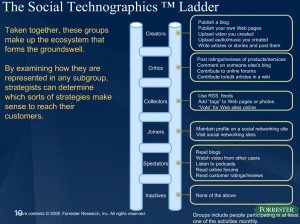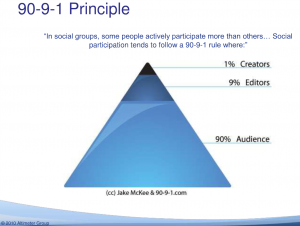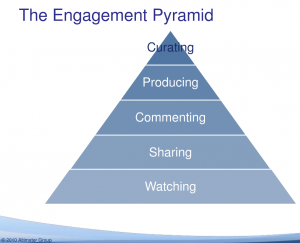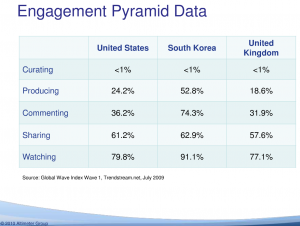Category Archives: Community Management
Feelings lead to action
Richard Millington’s post today got me thinking…
Feelings provoke actions… Focus on making members feel more engaged, not act more engaged.
Many times a day, Front Porch Forum pilot members are moved to be more engaged in FPF… and, more importantly, many are move to be more engaged in their actual/non-virtual neighborhood. This is often brought about by feelings elicited by an FPF posting from a neighbor.
Here are two key references from Millington…
You’ve probably come across the technographics ladder or the socialgraphics engagement pyramid. These categorize members by their actions. Lurkers are at the bottom, creators at the top. Sharing, reading, tagging are in-between.
First, the technographics ladder…

And the socialgraphics engagement pyramid…



Where do social enterprises fit on the spectrum of organizations?
Front Porch Forum is a mission-drive for-profit business located in Vermont. Once a year, we ask our tens of thousands of member households to consider chipping in $10 to $100 as a contribution to help us maintain, improve and expand FPF. This is strictly voluntary… FPF is a free service. It’s also not a charitable contribution, nor is it tax deductible.
This puts FPF in a position unfamiliar to many… “is FPF a charity or a business?” We’ve heard that more than once. We know that the economy and world are more complex than that. That’s why this graphic found today on Working Wikily appeals to me. It’s from Canada’s Social Innovation Generation‘s Task Force on Social Finance report: Mobilizing Private Capital for Public Good.

I’d say FPF is in the “social purpose business” to “socially responsible business” range.
How best to attract neighbors to online community?
From Richard Millington at FeverBee…
Which of these communities would you most like to join?
- An online community for local residents to participate in the public consultation process and have their say on everything from planning permission, budget allocation and
- An exclusive online community for local residents to prove their knowledge and share top tips on which local services to trust, best places to eat/shop and trade goods.
- An exclusive online community to learn the latest gossip about your neighbours and discover who’s hot or not in your local community.
Most councils/local government authorities will say the first.
Most residents say the second option works best.
Most people would actually join the gossip community.
You can treat this as a dismal reflection of modern society or as a great opportunity. Increasingly I suspect the key to developing a successful local community (or any community) is to begin with the gossip, move on to offer value and then aim for engagement on matters that affect the entire community.
Not all types of communications are equal
Richard Millington wrote today on FeverBee…
Not all types of communications are equal. When you meet someone in person you form a deeper relationship with them than thousands of online interactions.
We’re increasingly seeing a hierarchy of contact. At the lowest levels members talk via contributing content which others read. It’s slow, thoughtful and not interactive.
At the higher levels are immediate response, real-time communication and stronger context (i.e. talking by IM is stronger than chat-rooms – you had to add that person to your instant messenger).
- Members communicate in person.
- Members communicate by phone.
- Members communicate by voice-chat.
- Members communicate in IM/SMS.
- Members communicate in chat-rooms.
- Members communicate by social networks.
- Members communicate by forums.
- Members communicate via Twitter.
- Members communicate by blog posts/videos/UGC.
You do well when you try to get members communicating at the higher levels. Members form closer bonds and participation increases.
Front Porch Forum often starts with one person’s posting that is read by many. Then the fun begins… it sparks responses on FPF, as well as direct emails to the original author, phone calls, etc. And… highest on Richard’s list… that one posting leads to face to face conversation among neighbors on actual front porches (and sidewalks, country stores, playgrounds, etc.).
Where to focus limited resources?
Our portfolio company Meetup has learned to focus on successful Meetup groups. Those are Meetup groups that are active, meeting regularly, have growing memberships, and are paying fees to Meetup. Meetup could focus on other data sets like monthly unique visitors, new Meetup groups, total registered users, revenues, profits, cash. They collect that data and share it with the team. But the number one thing they look at it successful Meetup groups and that has worked well for them. It is their key business metric.
In Front Porch Forum’s pilot network, we host 140 online neighborhood forums. As with Meetup, the groups’ levels of activity and success vary tremendously. Good food for thought.
Cooperation vs. Competion or Regulation
Scott Heiferman’s tweet led me to take a closer look at the work of recent Nobel Laureate (economics) Elinor Ostrom. She studies how cooperation works best in some cases… better than competition or regulation… our two dominant forms of organizing markets. From a Forbes article…
Garrett Hardin called his famous 1968 essay on shared resources “The Tragedy of the Commons.” He argued that a shared village grazing pasture would tend to get overused and eventually destroyed. But even Hardin later acknowledged that shared common resources did not inevitably have to end in destruction, saying that he should have called his essay “The Tragedy of the Unmanaged Commons.”
And from Fran Korton’s interview at Shareable…
Fran: It’s interesting that your research is about people learning to cooperate…
Elinor: I have a new book coming out in May entitled Working Together, written with Amy Poteete and Marco Janssen. It is on collective actions in the commons. What we’re talking about is how people work together. We’ve used an immense array of different methods to look at this question “case studies, including my own dissertation and Amy’s work, modeling, experiments, large-scale statistical work. We show how people use multiple methods to work together.
Fran: Many people associate “the commons” with Garrett Hardin’s famous essay, “The Tragedy of the Commons.”… What’s the difference between your perspective and Hardin’s?
Elinor: Well, I don’t see the human as hopeless. There’s a general tendency to presume people just act for short-term profit. But anyone who knows about small-town businesses and how people in a community relate to one another realizes that many of those decisions are not just for profit and that humans do try to organize and solve problems.
If you are in a fishery or have a pasture and you know your family’s long-term benefit is that you don’t destroy it, and if you can talk with the other people who use that resource, then you may well figure out rules that fit that local setting and organize to enforce them. But if the community doesn’t have a good way of communicating with each other or the costs of self-organization are too high, then they won’t organize, and there will be failures.
Fran: So, are you saying that Hardin is sometimes right?
Elinor: Yes. People say I disproved him, and I come back and say “No, that’s not right. I’ve not disproved him. I’ve shown that his assertion that common property will always be degraded is wrong.” But he was addressing a problem of considerable significance that we need to take seriously. It’s just that he went too far. He said people could never manage the commons well.
At the Workshop we’ve done experiments where we create an artificial form of common property such as an imaginary fishery or pasture, and we bring people into a lab and have them make decisions about that property. When we don’t allow any communication among the players, then they overharvest [the commons]. But when people can communicate, particularly on a face-to-face basis, and say, “Well, gee, how about if we do this? How about we do that?” Then they can come to an agreement.
That last bit there about communication leading to better community decisions… love it. It’s so obvious. I guess that’s why it takes a non-economist Nobel Laureate in Economics to explain it to the economists of the world. And, for what it’s worth, her observation jibes with what we see at Front Porch Forum too. FPF leads to better communication among neighbors, more face-to-face conversation, and, in many cases, better community decisions.
Congratulations Dr. Ostrom!
Breaking down social media
How do you compare what Facebook does with Twitter, YouTube, or our own Front Porch Forum? Apples and oranges in many ways. Dan Schultz at MediaShift Idea Lab provides a framework for thinking about this today. Here’s his chart…

About Blog
Ghost of Midnight is an online journal about fostering community within neighborhoods, with a special focus on Front Porch Forum (FPF). My wife, Valerie, and I founded FPF in 2006... read more
Post Categories
- Uncategorized
- PDF2009
- Calendar
- Northeast Kingdom
- podcast
- Peer Rental
- Localization
- Big Tech
- Events
- PDF2007
- Web Traffic
- Google AdSense
- Pay It Forward
- Elections
- berkmansunlight
- Maps
- Video
- Upstate New York
- Coupons
- Wildlife
- Mobile
- Viral Marketing
- Raffle
- Crisis Response
- Donations
- Lost & Found
- Real Estate
- College Students
- Gratitude
- Social Responsibility
- Orton Family Foundation
- Start ups
- Make It Your Own Awards
- Online Civility
- Clay Shirky
- Newspapers
- Humor
- How To Use FPF
- Best of FPF
- Online Classified Ads
- Peer Reviews
- Politics
- Community Management
- Economic Development
- Local Reviews
- Case Foundation
- Borrow and Lend
- Neighborhood Watch
- Good Government
- Small Business Advertising
- Citizen Journalism
- e-Vermont
- Democracy
- Local Search
- Knight Foundation
- Burlington
- MacArthur Fellows
- Civic Engagement
- Social Media
- social capital
- Social Networking
- Vermont
- Neighborhood
- Community Building
- Local Online
- Front Porch Forum